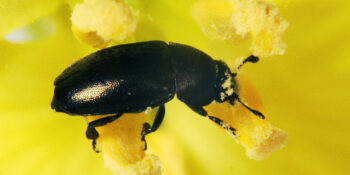Appearance
The adult beetles are up to 2.5 mm long and bronze greenish to blue/black and highly visible against a yellow background. The larvae are creamy-white, 3-4 mm long, with a brown/black head and 3 pairs of short brown legs. The uppersides of the body of the larvae are lightly coloured with dark brown spot
Presence
Pollen beetles are a pest of the green/yellow bud stage, adults and larvae feed on developing anther in buds and pollen in flowers. Holes can be found in developing buds where the beetles have eaten through the sepals to reach the stamens. As a result, there may be widespread bud abortion and a reduction in pod-sets and blind stalks. Due to their feeding habits spring oilseed rape can be highly susceptible to the attack of pollen beetles.
Pollen beetles tend to lay their eggs in flower buds and these hatch after 7-10 days, after this the larvae pupate in the soil. As adults emerge in mid-summer they serve as beneficial pollinators at flowering.
Damage
Pollen beetles migrate to winter oilseed rape crops from mid-March and throughout April. Eggs are laid in the flower buds and the larvae (grubs) develop within the flowers. If flowers are not open, beetles bite into and kill buds. Damage to buds declines as the flowers begin to open and pollen becomes more easily obtainable. Egg laying damage to the buds of oilseed rape can cause the flowers to drop off. Both adults and larvae feed on the pollen and nectar in the flowers. Struggling crops may produce fewer side shoots and green buds, meaning lower pollen beetle numbers could be a threat. In recent years, pollen beetles have rarely been abundant enough to warrant treatment: careful monitoring can prevent unnecessary 'insurance' sprays and preserve the efficacy of pyrethroid products.
Control recommendations
Monitor crops from green to yellow bud whenever temperature is 15ºC or higher. Don't panic spray - oilseed rape can tolerate quite a lot of damage by compensatory regrowth. Please check if the AHDB thresholds in the table below have been exceeded. Sample at least 10 plants along a 30 metre transect from the middle of the headland towards the centre of the crop and calculate the average number of beetles per plant. Once pest levels ARE ABOVE THRESHOLD treatment is justified to protect yield - apply a full rate of pyrethroid to minimise the risk of resistance development. If beetles are still active and numbers exceed the threshold three days after treatment try using an insecticide with an alternative mode of action such as indoxacarb. None of these may be used more than once in a crop.
Spraying when pest levels are low increases the risk of resistance evolving in the pest and also may kill natural enemies of the pest or other beneficial insects. Resistance to pyrethroids has been reported since 1999 in mainland Europe and is spreading in the UK.
Do NOT spray after flowering starts: the pollen beetles migrate to open flowers, away from the buds, and become pollinators rather than pests.
Treatment thresholds
Current spray thresholds for winter and spring oilseed rape are:
|
Plants/sq m |
Pollen beetles per plant |
|
< 30 |
25 |
|
30-50 |
18 |
|
50-70 |
11 |
|
>70 |
7 |
Pollen beetle larvae are attacked by parasitic wasps. 25-50% of larvae are killed by these on unsprayed crops. Where insecticides are used extensively, levels of parasitism can be considerably lower. The parasitic wasps may not be affected by insecticides applied against pollen beetle at green bud, as they arrive in crops during flowering.
Related Links
https://cropscience.bayer.co.uk/threats/pest-and-slugs/pollen-beetle/
Monitoring and control of pollen beetle in oilseed rape
Some of the text and image on this page comes from Rothamsted's Croprotect web platform at https://croprotect.com/pests/pollen-beetle








